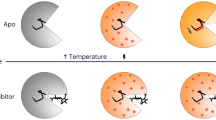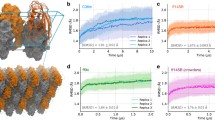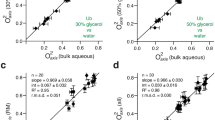Abstract
Solvent dynamics can play a major role in enzyme activity, but obtaining an accurate, quantitative picture of solvent activity during catalysis is quite challenging. Here, we combine terahertz spectroscopy and X-ray absorption analyses to measure changes in the coupled water-protein motions during peptide hydrolysis by a zinc-dependent human metalloprotease. These changes were tightly correlated with rearrangements at the active site during the formation of productive enzyme-substrate intermediates and were different from those in an enzyme–inhibitor complex. Molecular dynamics simulations showed a steep gradient of fast-to-slow coupled protein-water motions around the protein, active site and substrate. Our results show that water retardation occurs before formation of the functional Michaelis complex. We propose that the observed gradient of coupled protein-water motions may assist enzyme-substrate interactions through water-polarizing mechanisms that are remotely mediated by the catalytic metal ion and the enzyme active site.
This is a preview of subscription content, access via your institution
Access options
Subscribe to this journal
Receive 12 print issues and online access
$189.00 per year
only $15.75 per issue
Buy this article
- Purchase on Springer Link
- Instant access to full article PDF
Prices may be subject to local taxes which are calculated during checkout





Similar content being viewed by others
Accession codes
References
Koshland, D.E. Application of a theory of enzyme specificity to protein synthesis. Proc. Natl. Acad. Sci. USA 44, 98–104 (1958).
Benkovic, S.J., Hammes, G.G. & Hammes-Schiffer, S. Free-energy landscape of enzyme catalysis. Biochemistry 47, 3317–3321 (2008).
Henzler-Wildman, K.A. et al. A hierarchy of timescales in protein dynamics is linked to enzyme catalysis. Nature 450, 913–916 (2007).
Benkovic, S.J. & Hammes-Schiffer, S. A perspective on enzyme catalysis. Science 301, 1196–1202 (2003).
Bourgeois, D. & Royant, A. Advances in kinetic protein crystallography. Curr. Opin. Struct. Biol. 15, 538–547 (2005).
Dodson, G.G., Lane, D.P. & Verma, C.S. Molecular simulations of protein dynamics: new windows on mechanisms in biology. EMBO Rep. 9, 144–150 (2008).
Eisenmesser, E.Z. et al. Intrinsic dynamics of an enzyme underlies catalysis. Nature 438, 117–121 (2005).
Mittermaier, A. & Kay, L.E. New tools provide new insights in NMR studies of protein dynamics. Science 312, 224–228 (2006).
Pieper, J. et al. Temperature- and hydration-dependent protein dynamics in photosystem II of green plants studied by quasielastic neutron scattering. Biochemistry 46, 11398–11409 (2007).
Schotte, F. et al. Watching a protein as it functions with 150-ps time-resolved X-ray crystallography. Science 300, 1944–1947 (2003).
Zaccai, G. How soft is a protein? A protein dynamics force constant measured by neutron scattering. Science 288, 1604–1607 (2000).
Nashine, V.C., Hammes-Schiffer, S. & Benkovic, S.J. Coupled motions in enzyme catalysis. Curr. Opin. Chem. Biol. 14, 644–651 (2010).
Kamerlin, S.C. & Warshel, A. At the dawn of the 21st century: Is dynamics the missing link for understanding enzyme catalysis? Proteins 78, 1339–1375 (2010).
Schwartz, S.D. & Schramm, V.L. Enzymatic transition states and dynamic motion in barrier crossing. Nat. Chem. Biol. 5, 551–558 (2009).
Marlow, M.S., Dogan, J., Frederick, K.K., Valentine, K.G. & Wand, A.J. The role of conformational entropy in molecular recognition by calmodulin. Nat. Chem. Biol. 6, 352–358 (2010).
Barron, L.D., Hecht, L. & Wilson, G. The lubricant of life: a proposal that solvent water promotes extremely fast conformational fluctuations in mobile heteropolypeptide structure. Biochemistry 36, 13143–13147 (1997).
Fenimore, P.W., Frauenfelder, H., McMahon, B.H. & Young, R.D. Bulk-solvent and hydration-shell fluctuations, similar to alpha- and beta-fluctuations in glasses, control protein motions and functions. Proc. Natl. Acad. Sci. USA 101, 14408–14413 (2004).
Frauenfelder, H., Fenimore, P.W., Chen, G. & McMahon, B.H. Protein folding is slaved to solvent motions. Proc. Natl. Acad. Sci. USA 103, 15469–15472 (2006).
Hunt, N.T., Kattner, L., Shanks, R.P. & Wynne, K. The dynamics of water-protein interaction studied by ultrafast optical Kerr-effect spectroscopy. J. Am. Chem. Soc. 129, 3168–3172 (2007).
Dér, A. et al. Interfacial water structure controls protein conformation. J. Phys. Chem. B 111, 5344–5350 (2007).
Papoian, G.A., Ulander, J., Eastwood, M.P., Luthey-Schulten, Z. & Wolynes, P.G. Water in protein structure prediction. Proc. Natl. Acad. Sci. USA 101, 3352–3357 (2004).
Klibanov, A.M. Improving enzymes by using them in organic solvents. Nature 409, 241–246 (2001).
Levitt, M. & Park, B.H. Water: now you see it, now you don't. Structure 1, 223–226 (1993).
Levy, Y. & Onuchic, J.N. Water mediation in protein folding and molecular recognition. Annu. Rev. Biophys. Biomol. Struct. 35, 389–415 (2006).
Cheung, M.S., Garcia, A.E. & Onuchic, J.N. Protein folding mediated by solvation: water expulsion and formation of the hydrophobic core occur after the structural collapse. Proc. Natl. Acad. Sci. USA 99, 685–690 (2002).
Rhee, Y.M., Sorin, E.J., Jayachandran, G., Lindahl, E. & Pande, V.S. Simulations of the role of water in the protein-folding mechanism. Proc. Natl. Acad. Sci. USA 101, 6456–6461 (2004).
Chaplin, M. Do we underestimate the importance of water in cell biology? Nat. Rev. Mol. Cell Biol. 7, 861–866 (2006).
Eisenmesser, E.Z., Bosco, D.A., Akke, M. & Kern, D. Enzyme dynamics during catalysis. Science 295, 1520–1523 (2002).
Robinson, C.R. & Sligar, S.G. Changes in solvation during DNA binding and cleavage are critical to altered specificity of the EcoRI endonuclease. Proc. Natl. Acad. Sci. USA 95, 2186–2191 (1998).
Durin, G. et al. Simultaneous measurements of solvent dynamics and functional kinetics in a light-activated enzyme. Biophys. J. 96, 1902–1910 (2009).
Daniel, R.M., Dunn, R.V., Finney, J.L. & Smith, J.C. The role of dynamics in enzyme activity. Annu. Rev. Biophys. Biomol. Struct. 32, 69–92 (2003).
Kleifeld, O., Frenkel, A., Martin, J.M. & Sagi, I. Active site electronic structure and dynamics during metalloenzyme catalysis. Nat. Struct. Biol. 10, 98–103 (2003).
Solomon, A., Akabayov, B., Frenkel, A., Milla, M.E. & Sagi, I. Key feature of the catalytic cycle of TNF-alpha converting enzyme involves communication between distal protein sites and the enzyme catalytic core. Proc. Natl. Acad. Sci. USA 104, 4931–4936 (2007).
Kim, S.J., Born, B., Havenith, M. & Gruebele, M. Real-time detection of protein-water dynamics upon protein folding by terahertz absorption spectroscopy. Angew. Chem. Int. Edn Engl. 47, 6486–6489 (2008).
Osenkowski, P., Toth, M. & Fridman, R. Processing, shedding, and endocytosis of membrane type 1-matrix metalloproteinase (MT1-MMP). J. Cell. Physiol. 200, 2–10 (2004).
Neumann, U., Kubota, H., Frei, K., Ganu, V. & Leppert, D. Characterization of Mca-Lys-Pro-Leu-Gly-Leu-Dpa-Ala-Arg-NH2, a fluorogenic substrate with increased specificity constants for collagenases and tumor necrosis factor converting enzyme. Anal. Biochem. 328, 166–173 (2004).
Ebbinghaus, S. et al. An extended dynamical hydration shell around proteins. Proc. Natl. Acad. Sci. USA 104, 20749–20752 (2007).
Heugen, U. et al. Solute-induced retardation of water dynamics probed directly by terahertz spectroscopy. Proc. Natl. Acad. Sci. USA 103, 12301–12306 (2006).
Heyden, M. et al. Dissecting the THz spectrum of liquid water from first principles through correlations in time and space. Proc. Natl. Acad. Sci. USA 107, 12068–12073 (2010).
Pal, S.K., Peon, J. & Zewail, A.H. Biological water at the protein surface: dynamical solvation probed directly with femtosecond resolution. Proc. Natl. Acad. Sci. USA 99, 1763–1768 (2002).
Fenimore, P.W., Frauenfelder, H., McMahon, B.H. & Parak, F.G. Slaving: solvent fluctuations dominate protein dynamics and functions. Proc. Natl. Acad. Sci. USA 99, 16047–16051 (2002).
Arikawa, T., Nagai, M. & Tanaka, K. Characterizing hydration state in solution using terahertz time-domain attenuated total reflection spectroscopy. Chem. Phys. Lett. 457, 12–17 (2008).
Heyden, M. & Havenith, M. Combining THz spectroscopy and MD simulations to study protein-hydration coupling. Methods 52, 74–83 (2010).
Rosenblum, G. et al. Molecular structures and dynamics of the stepwise activation mechanism of a matrix metalloproteinase zymogen: challenging the cysteine switch dogma. J. Am. Chem. Soc. 129, 13566–13574 (2007).
Frenkel, A.I., Kleifeld, O., Wasserman, S.R. & Sagi, I. Phase speciation by extended X-ray absorption fine structure spectroscopy. J. Chem. Phys. 116, 9449–9456 (2002).
Nagase, H., Fields, C.G. & Fields, G.B. Design and characterization of a fluorogenic substrate selectively hydrolyzed by stromelysin 1 (matrix metalloproteinase-3). J. Biol. Chem. 269, 20952–20957 (1994).
Fernandez-Catalan, C. et al. Crystal structure of the complex formed by the membrane type 1-matrix metalloproteinase with the tissue inhibitor of metalloproteinases-2, the soluble progelatinase A receptor. EMBO J. 17, 5238–5248 (1998).
Grossman, M. et al. The intrinsic protein flexibility of endogenous protease inhibitor TIMP-1 controls its binding interface and affects its function. Biochemistry 49, 6184–6192 (2010).
Bruice, T.C. & Benkovic, S.J. Chemical basis for enzyme catalysis. Biochemistry 39, 6267–6274 (2000).
Agarwal, P.K. Role of protein dynamics in reaction rate enhancement by enzymes. J. Am. Chem. Soc. 127, 15248–15256 (2005).
Exter, M.v., Fattinger, C. & Grischkowsky, D. Terahertz time-domain spectroscopy of water vapor. Opt. Lett. 14, 1128–1130 (1989).
Kindt, J.T. & Schmuttenmaer, C.A. Far-infrared dielectric properties of polar liquids probed by femtosecond terahertz pulse spectroscopy. J. Phys. Chem. 100, 10373–10379 (1996).
Lee, M.H., Rapti, M., Knauper, V. & Murphy, G. Threonine 98, the pivotal residue of tissue inhibitor of metalloproteinases (TIMP)-1 in metalloproteinase recognition. J. Biol. Chem. 279, 17562–17569 (2004).
Spoel, D.V.D. et al. GROMACS: Fast, flexible, and free. J. Comput. Chem. 26, 1701–1718 (2005).
Scott, W.R.P. et al. The GROMOS biomolecular simulation program package. J. Phys. Chem. A 103, 3596–3607 (1999).
Acknowledgements
We thank A. Frenkel (Yeshiva University), J. Bohon, M. Sullivan (beam line X3B at the National Synchrotron Light Source), I. Solomonov and Y. Udi (Weizmann Institute of Science) for help with X-ray absorption data collection, and we thank M. Krüger (Ruhr-University Bochum) for programming the THz data acquisition software. We thank G. Murphy (Cambridge Research Institute) for the plasmid encoding TIMP-2. We acknowledge financial support by the Ministry of Innovation, Science, Research and Technology of the German state of North Rhine-Westphalia and by the Ruhr-University Bochum and thank the Ressourcenverbund North Rhine-Westphalia for computer time. B.B. and M.He. were members of the Ruhr-University Research School funded by Germany's Excellence Initiative (DFG GSC 98/1). B.B. is grateful to the Feinberg Graduate School at the Weizmann Institute for a Dean of Faculty fellowship. M.He. was a fellow of the Studienstiftung des Deutschen Volkes. G.B.F. is supported by the Robert A. Welch Foundation. G.B.F. and I.S. are supported by a US National Institutes of Health grant (CA098799). I.S. is supported by the Israel Science Foundation, the Kimmelman Center at the Weizmann Institute and the Ambach family fund. M.Ha. is supported by the VW Stiftung.
Author information
Authors and Affiliations
Contributions
I.S. and M.Ha. are equal contributors and designed the experiments, analyzed the data and wrote the manuscript. M.G., B.B. and M.He. are equal contributors and conducted the research, analyzed the data and wrote the manuscript. D.T. constructed the enzyme-substrate docking model. G.B.F. provided the substrates.
Corresponding authors
Ethics declarations
Competing interests
The authors declare no competing financial interests.
Supplementary information
Supplementary Text and Figures
Supplementary Figures 1–5, Supplementary Table 1 and Supplementary Methods (PDF 1549 kb)
Rights and permissions
About this article
Cite this article
Grossman, M., Born, B., Heyden, M. et al. Correlated structural kinetics and retarded solvent dynamics at the metalloprotease active site. Nat Struct Mol Biol 18, 1102–1108 (2011). https://doi.org/10.1038/nsmb.2120
Received:
Accepted:
Published:
Issue Date:
DOI: https://doi.org/10.1038/nsmb.2120
This article is cited by
-
Chasing weakly-bound biological water in aqueous environment near the peptide backbone by ultrafast 2D infrared spectroscopy
Communications Chemistry (2024)
-
Terahertz spectroscopy as a method for investigation of hydration shells of biomolecules
Biophysical Reviews (2023)
-
The shape of water in zeolites and its impact on epoxidation catalysis
Nature Catalysis (2021)
-
Temperature-jump solution X-ray scattering reveals distinct motions in a dynamic enzyme
Nature Chemistry (2019)
-
Strong coupling of collective intermolecular vibrations in organic materials at terahertz frequencies
Nature Communications (2019)



